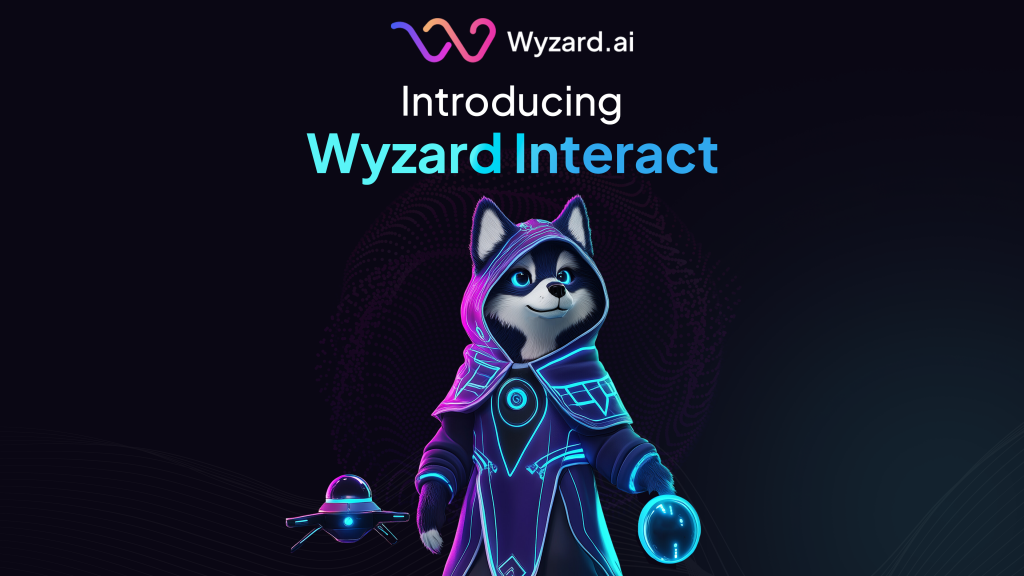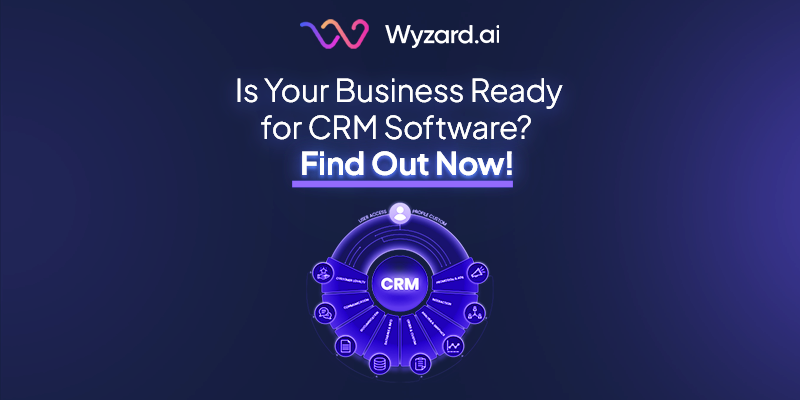Hi, I am Wyzard, your visionary guide in a world where the buying experience is transforming. The way we ...
The CFO’s Guide to Tech Spend Optimization: Best Strategies and Tactics
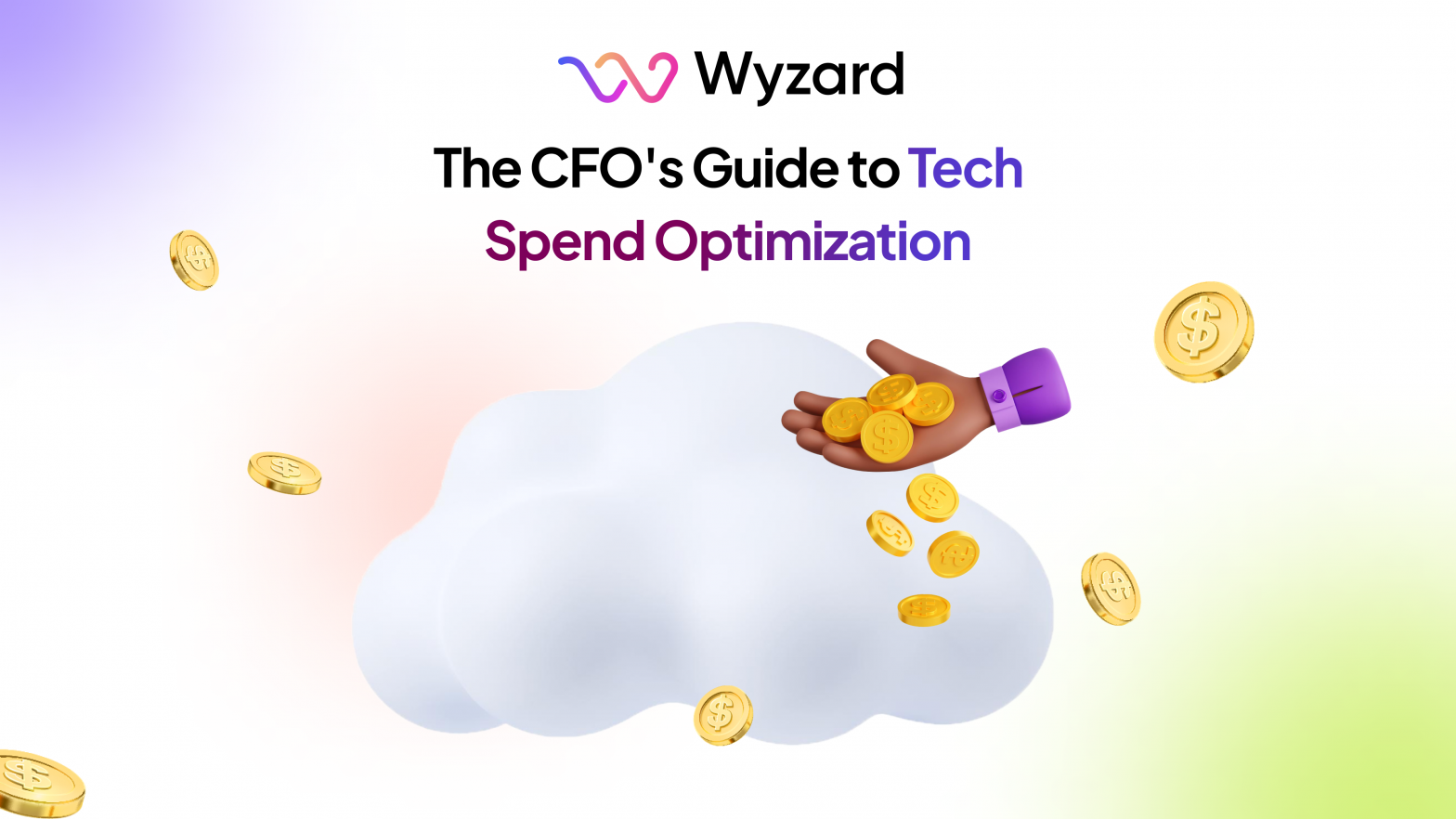

Subscribe Now
Businesses across industries are investing heavily in technology. A significant portion of their revenue is allocated to software, hardware, and various tech solutions. And it makes sense considering the role of tech in streamlining operations.
According to estimates from consultants and research firms like Deloitte, small and medium-sized businesses allocate 6% to 8% of their revenue to IT expenditures, while enterprise-sized companies spend 2% to 4% on technology.
However, organizations with large IT requirements, such as cloud and managed service providers, can dedicate up to 50% of their revenue to technology.
So, let’s say your revenue is $50 million; at least $1 million of that goes to your tech stack. And yes, the amount is considerable enough to be optimized.
The finance department plays a crucial role in monitoring budgets, cash flow, and ensuring that every dollar is spent judiciously.
However, when it comes to technology spending, CFOs often face challenges in maintaining visibility and control. And the risks of not optimizing tech spending can be significant, particularly during economic downturns or periods of financial uncertainty.
In this CFO’s guide to tech spend optimization, we provide you with proven strategies to help you gain control over your organization’s technology expenses and prevent overspending on your tech investments.
Let’s dive right in!
What is Tech Spend Optimization?
Tech spend optimization is all about being smart about managing the money you spend on technology in your business.
Tech is everywhere. Software, hardware, cloud services, and the bills can really start piling up if you’re not careful. And we’re not just talking about the upfront costs. There are licenses to renew, upgrades to pay for, support and maintenance fees, the list goes on.
That’s where tech spend optimization comes in. It’s about monitoring all those tech expenses to figure out where to trim the cost without compromising efficiency.
You might be paying for software licenses you don’t need anymore. Or perhaps there’s a more cost-effective solution that does the job just as well.
The key is ensuring every dollar you spend on tech drives value for your business. Any savings you squeeze out can be reinvested into more productive areas to boost your bottom line.
10 Strategies for CFOs to Optimize Tech Spend
Before we dive into the nitty-gritty of it, here’s a CFO tech spend optimization checklist for you:
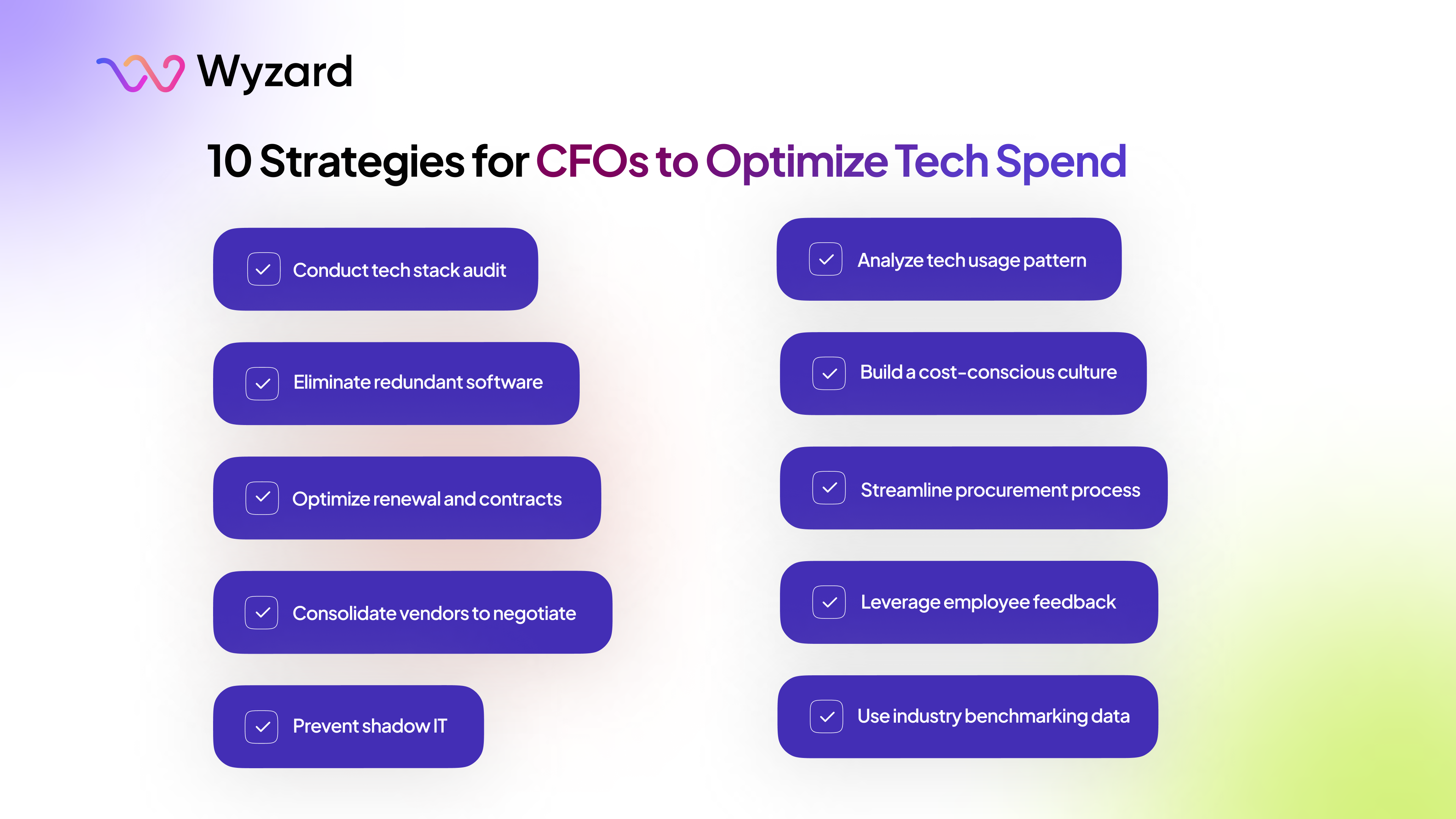
1. Conduct a comprehensive tech stack audit and spend analysis
The first step in optimizing your tech spend is knowing exactly what software, hardware, and services your business is paying for.
Sounds simple enough, but you’d be surprised how many companies lose track of their full tech stack over time.
Start by conducting a deep-dive audit. Make a master list of every tech solution you have, from the core systems running your business to that random mobile app subscription someone signed up for ages ago.
Once you have complete visibility, it’s time to analyze the costs. How much are you spending on each software every month or year? What’s the total annual spend?
With this information, you can start identifying areas that can be optimized. Maybe there are some unnecessary subscriptions still getting auto-renewed that nobody uses anymore. Or perhaps you spot some conspicuous cost spikes that need investigating.
The point is—you can’t fix what you can’t see. This tech stack audit helps you see.
2. Identify and eliminate redundant or underutilized software
Now that you have complete visibility into your tech stack, it’s time to get ruthless about cutting the bloat. Redundant or underutilized software is just dead weight, costing you money.
Redundant basically means having tools that you don’t need. For example, paying for three different video conferencing apps when one would suffice. It’s easy for this to happen as teams grow and adopt random new apps without centralized oversight.
Underutilized refers to shelfware—software licenses you’re paying for that aren’t properly used. Maybe there’s an expensive design suite that only gets occasional use by some employees or an AI tool that sounded cool but never got adopted.
Identify these redundancies and shelf-warmers, then be brutally honest about what you actually need versus what’s just taking up budget space.
3. Monitor and optimize software renewals and contracts
Pretty much every software vendor tries to pull the old auto-renewal fast. Unless you actively monitor and manage SaaS contract renewal, thousands of dollars could leak out annually.
Put an iron-clad renewal monitoring system in place. As contracts approach their end dates, proactively analyze whether renewals make sense based on current usage patterns. Identify any shelfware candidates to cull before auto-pay kicks in. And during renewal negotiations, go through the usage data to get rid of unnecessary license counts.
Speaking of negotiations, don’t just rubber stamp renewals either. Have your procurement team thoroughly review and re-negotiate each contract’s terms and pricing in your favor. These seemingly minor tweaks result in massive long-term savings.
4. Leverage vendor consolidation to negotiate better pricing
Even after eliminating the duplicate subscriptions, you’re likely still juggling various software vendors and services. That’s an opportunity for some negotiation.
You can leverage larger total contract values to negotiate better pricing and terms by consolidating multiple products or services under one vendor umbrella.
Vendors want your business and won’t need much convincing to give you a discount if it means landing a bigger overall deal.
Let’s say you’re paying for cloud hosting, productivity software, and CRM tools from three different providers. You may get a sweeter deal by consolidating those under one vendor that offers all those services. Having fewer relationships to manage is a bonus too.
5. Prevent shadow IT and unauthorized software purchases
Shadow IT—when employees circumvent established processes and procure software or services without the knowledge or approval of the IT department—can significantly undermine efforts toward tech spend optimization.
From a spend optimization standpoint, shadow IT poses several challenges. It leads to redundant software purchases, license sprawl, and potential security vulnerabilities. Furthermore, it undermines the ability to negotiate enterprise-wide agreements and leverage economies of scale, resulting in higher costs.
Did you know?
- Only 12% of IT teams can actually keep up with the constant flood of new tech requests.
- Getting hit by shadow IT costs companies over $4.2 million on average to clean up the mess.
- 30-40% of the IT budget at big companies gets totally blown on shadow IT.
As the CFO, you should crack down on shadow IT before it becomes widespread.
Implement strict procurement policies requiring IT approval for ANY new software. Deploy monitoring tools to sniff out unauthorized app usage.
More importantly, create an environment of open communication so people don’t feel the need to go rogue in the first place.
6. Analyze software usage patterns and right-size licenses
Teams often overbuy licenses “just in case,” leaving many unused seats. Or they jump to the highest pricing tier when a cheaper option would suffice.
The smart move, you ask?
- Implement detailed usage monitoring and reporting.
- See which features employees actually use versus what sits untouched.
- Identify the minimum viable license tier for each user profile.
- Don’t pay for what you don’t use.
Right-sizing those licenses can help you save a significant amount of money.
7. Build a cost-conscious culture within the organization
Even with the best software spend optimization strategies, you’ll just end up playing whack-a-mole if your organization lacks a cost-conscious culture.
Employees simply revert to their wasteful ways over time without constant reinforcement.
A CFO must build an environment where everyone, from interns to the C-suite, feels invested in spending money wisely.
Lead by example through your own diligent practices. Implement training programs to educate teams on the impacts of rampant tech spending. And for what it’s worth, maybe even gamify it with spending accountability leaderboards!
8. Implement a streamlined procurement process for new software acquisitions
As much as you want to optimize your current tech spending, it’s crucial to also monitor new acquisitions. Without a standardized software procurement process, you open yourself up to all sorts of spending inefficiencies.
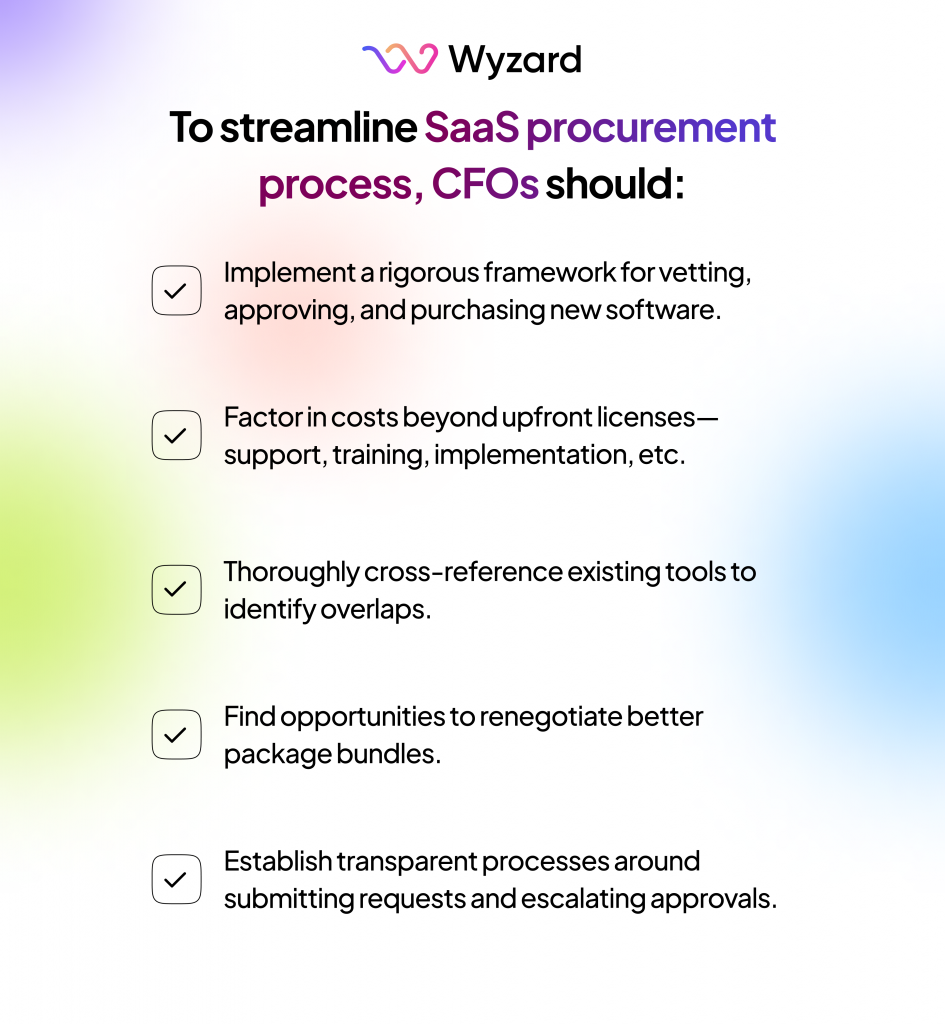
A tight, efficient procurement engine will prevent unnecessary software acquisition. You’ll also onboard new solutions more judiciously and cost-effectively.
9. Leverage employee feedback and sentiment to guide software decisions
At the end of the day, your employees are the ones actually using the software and feeling its impact on productivity.
Ignoring their voices during software evaluations is just asking for underutilized SaaS in your portfolio.
Actively solicit detailed user feedback and sentiment data as part of your decision-making process. Which tools are their favorites versus total time sinks? Where do they perceive redundancies or gaps in capabilities?
With this qualitative data in hand, you can prioritize software that generates legit enthusiasm and purge tools people resent.
10. Use benchmarking data to align tech spend with industry standards
Companies often grossly over or underspend on software compared to similar businesses. Usually, it comes down to operating in an information vacuum that lacks real data on industry pricing norms.
That’s why software spend benchmarking data is such a powerful optimization tool for CFOs.
If you’re an outlier on the high end, it exposes areas for optimization. Underspending could signal opportunities to invest in more robust, productivity-boosting tools.
Either way, benchmarking provides that crucial external frame of reference to inform your decisions.
How Can a SaaS Spend Management Tool Help CFOs in Tech Spend Optimization?
With so many disparate software tools and services in play, it’s easy for costs to spiral out of control.
That’s where dedicated SaaS spend management platforms like Wyzard can help CFOs looking to optimize their tech investments. Let’s find out how:
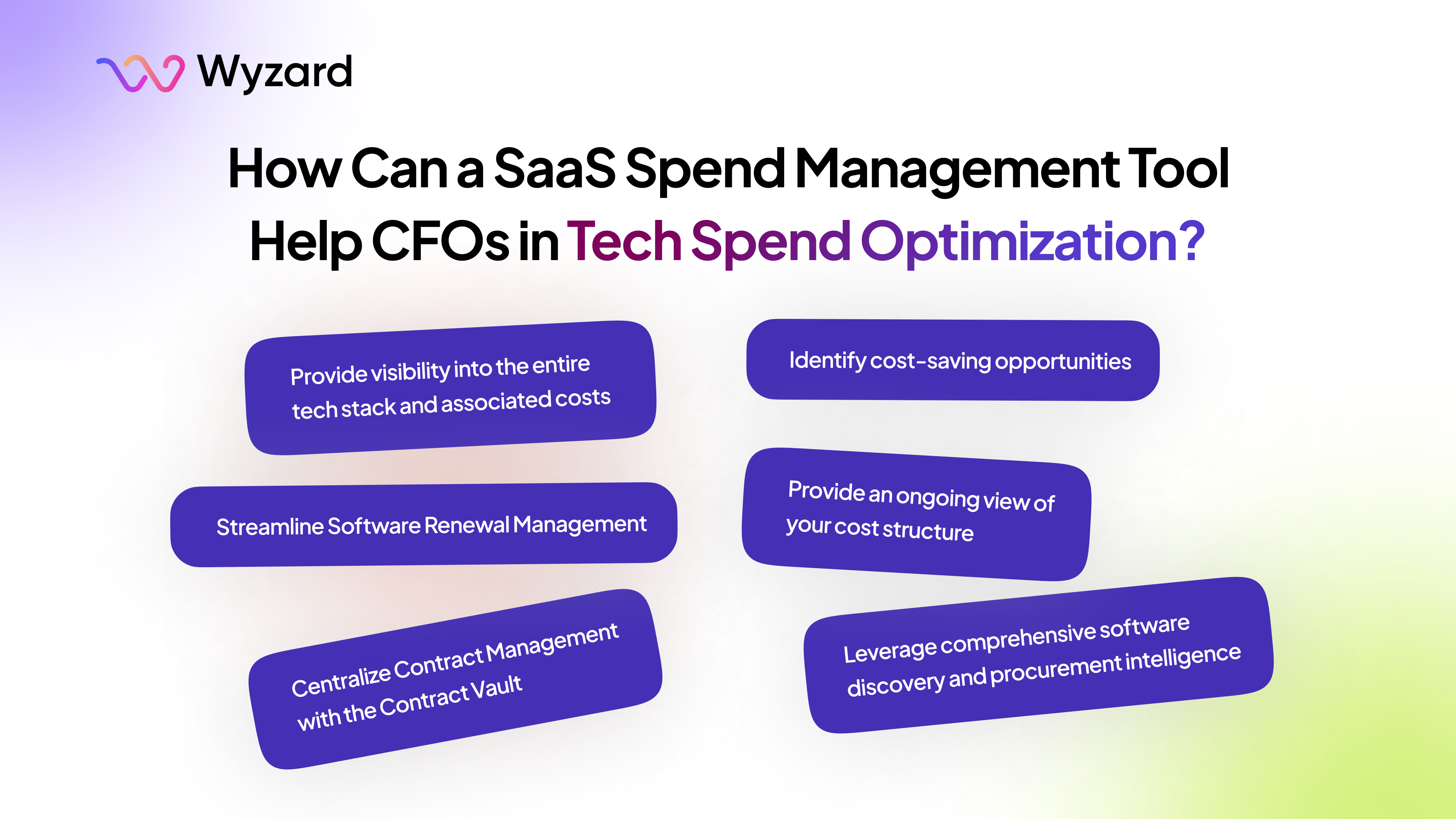
1. Provide visibility into the entire tech stack and associated costs
Manually tracking every single SaaS subscription and associated fees is just asking for costly blind spots and oversights.
Wyzard eliminates this guesswork by establishing complete visibility through deep API integrations and single sign-on capabilities.
It connects directly with all your SaaS applications, fetching real-time cost data to provide a detailed view of your technology stack and spend. It ensures that CFOs do not have to operate in the dark.
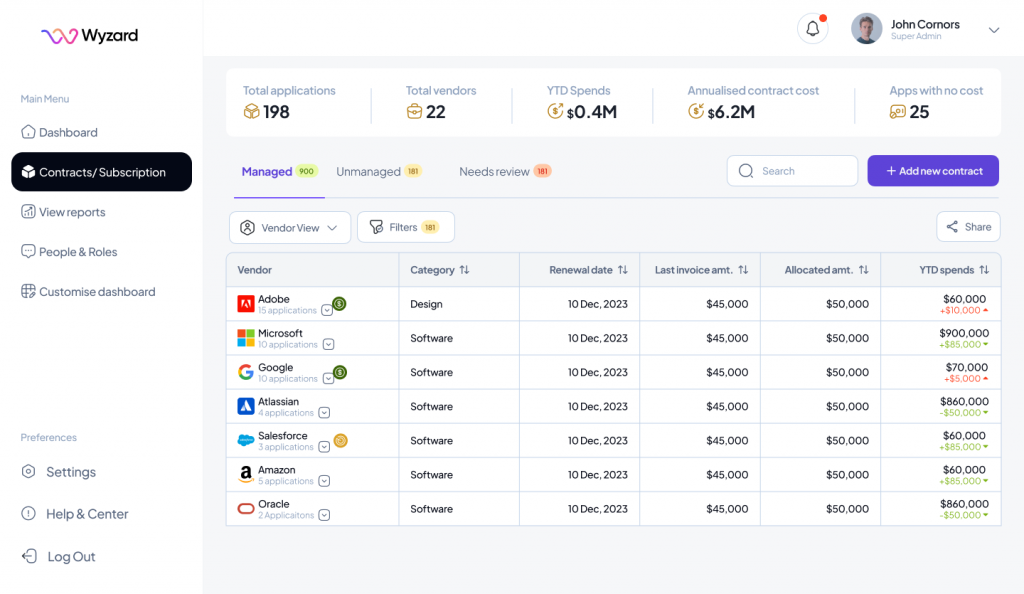
2. Identify cost-saving opportunities
Even with full spend visibility, identifying areas for optimization requires analyzing huge swaths of usage data—an impossible task through manual effort.
Wyzard’s AI-powered Engine processes real-time signals from your SaaS tools to pinpoint potential cost-savings like unused licenses, redundant software functionality, and more.
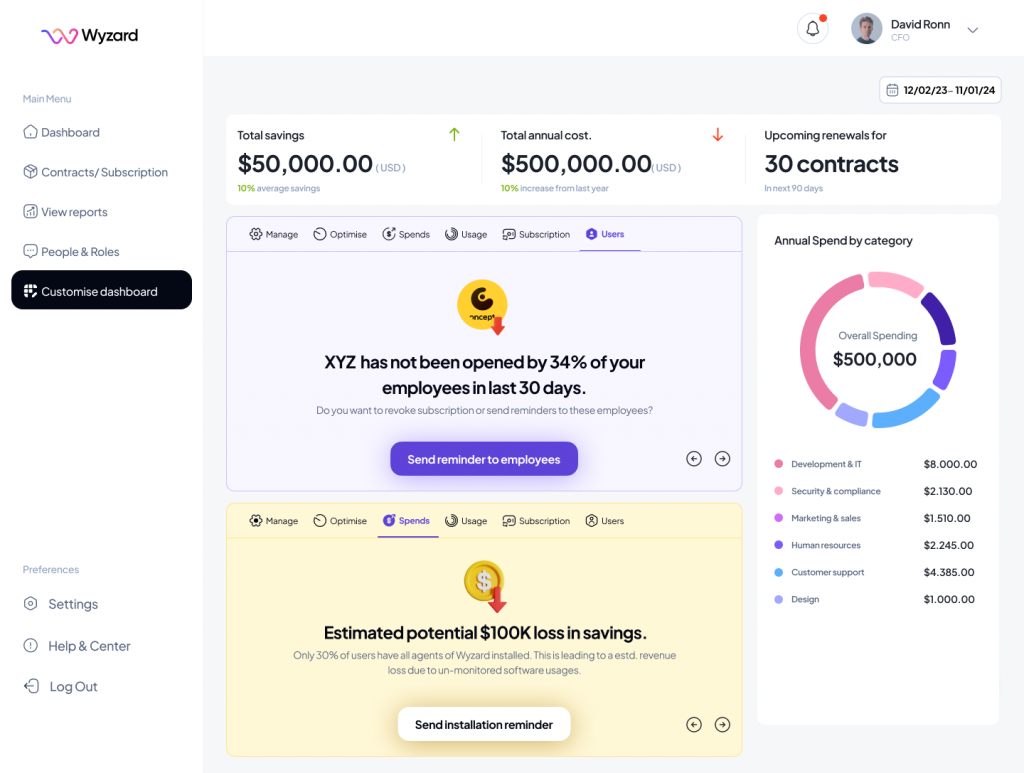
3. Streamline Software Renewal Management
When done manually, keeping track of SaaS subscription renewals and software license expirations can be a tedious and error-prone process with high stakes.
Missing a renewal deadline could be costly. Automatic renewals sometimes mean renewing at unfavorable terms because it’s not the most proactive of approaches.
Wyzard’s renewal management capabilities eliminate this administrative burden by automating the entire renewal lifecycle. With intelligent data extraction and timely alerts, you’ll never overpay or inadvertently trigger expensive auto-renewals.
Wyzard provides a centralized view of all upcoming renewals, empowering you to initiate renegotiations proactively and secure optimized deals aligned with your organization’s evolving needs.
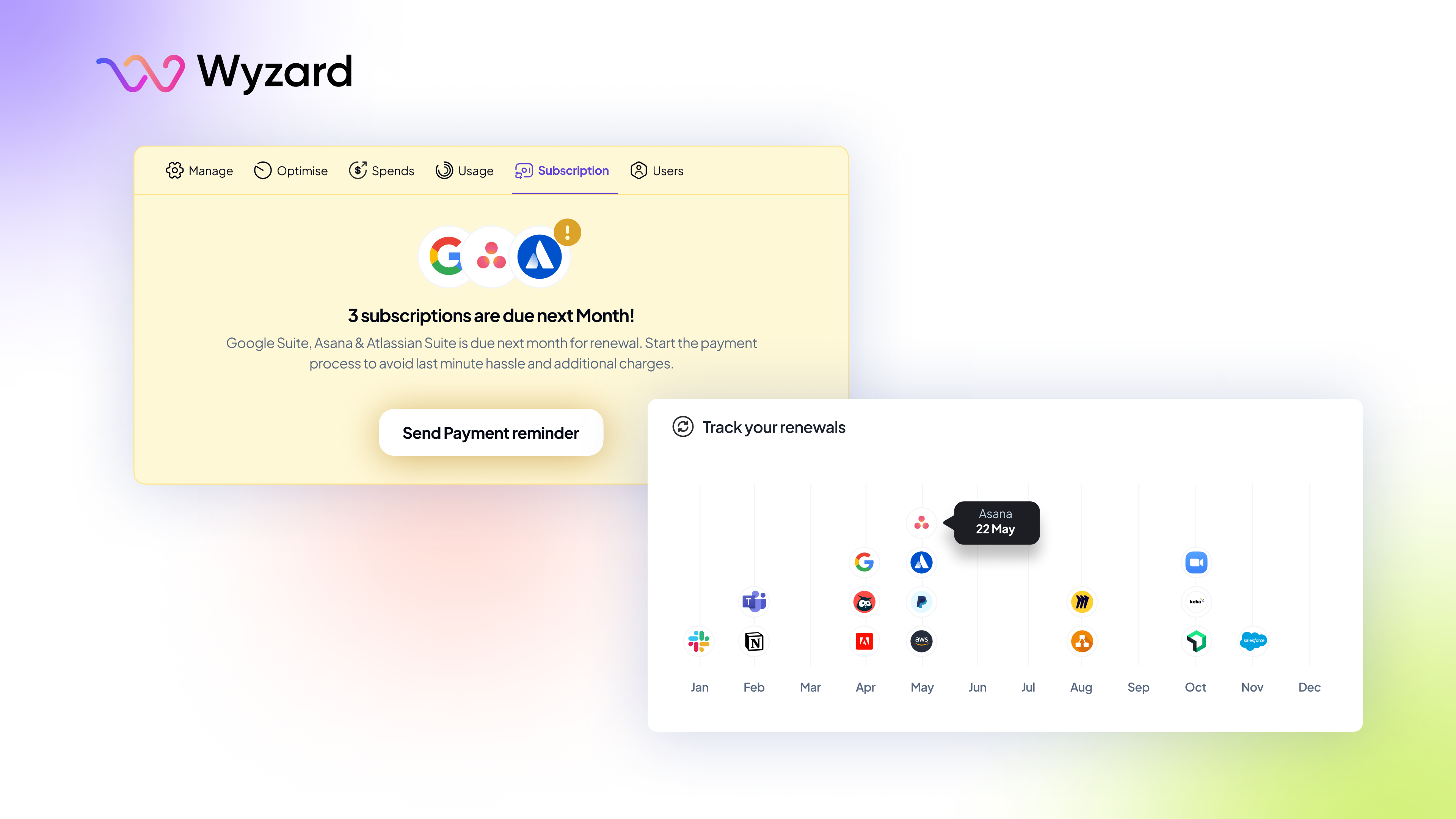
4. Centralize Contract Management with the Contract Vault
Effective contract management is crucial for controlling your tech stack and ensuring compliance.
However, dispersed contracts across various teams and repositories can make it challenging to access and review terms and conditions efficiently.
Wyzard’s Contract Vault is a secure, centralized repository for all your software contracts, licenses, and agreements.
With drag-and-drop functionality and intelligent data extraction, reviewing and searching through contract details becomes effortless.
The Contract Vault allows you to maintain a comprehensive view of your contractual obligations, rights, and dependencies, facilitating informed decision-making and mitigating potential risks associated with non-compliance or missed obligations.
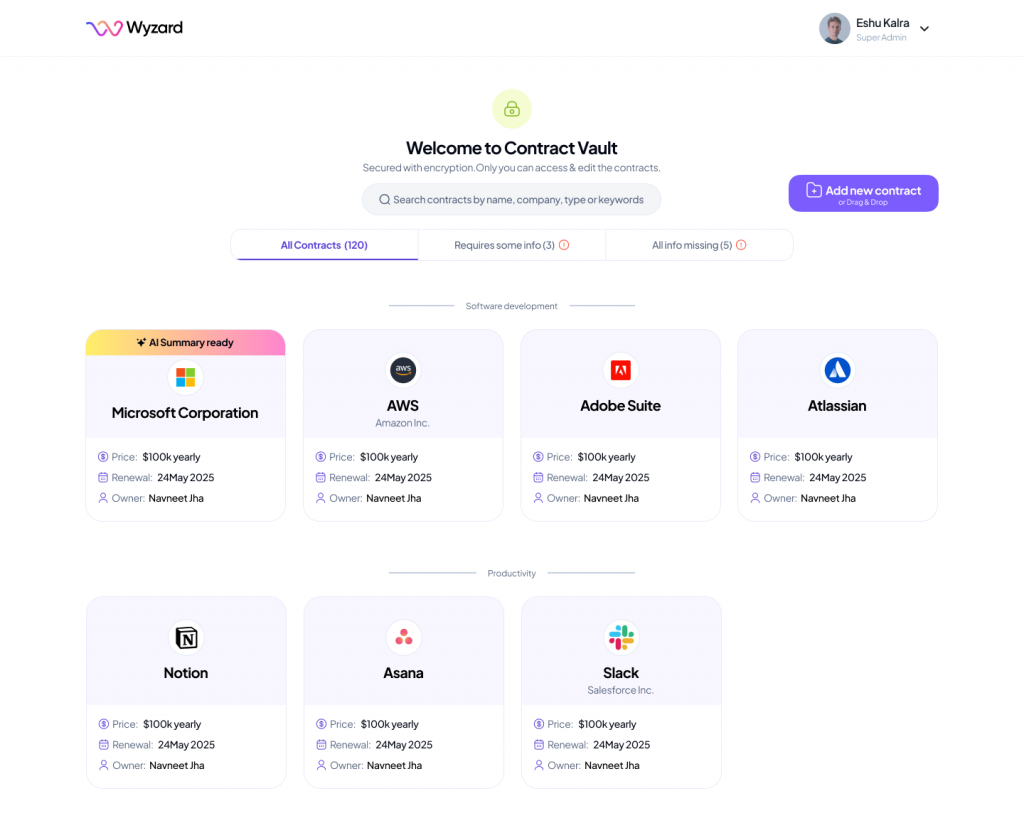
5. Leverage comprehensive software discovery and procurement intelligence
As a CFO, procuring new software solutions can often feel like dealing with a maze of unfamiliar options and convoluted pricing structures.
Wyzard provides comprehensive software discovery and procurement intelligence, streamlining the entire process from evaluation to negotiation.
The “Discover” feature provides complete transparency by granting access to a proprietary database of software solutions. This database offers detailed insights into product features, pricing models, and industry-specific use cases, enabling you to make well-informed decisions aligned with your organization’s unique requirements.
Before engaging in negotiations, Wyzard equips you with a deep understanding of the software you need and have, allowing you to gather relevant market intelligence and shortlist the most suitable options.
Once you’ve identified the desired solution, Wyzard’s cloud procurement advisory team steps in to support the negotiation process. With proven tactics and extensive industry experience, our experts work tirelessly to secure optimal pricing, favorable terms, and conditions that maximize value for your organization.
6. Provide an ongoing view of your cost structure
Optimizing tech spend is a continuous process, not a one-and-done event. Wyzard continuously monitors your evolving cost structures, delivering AI-powered budgeting and forecasting capabilities.
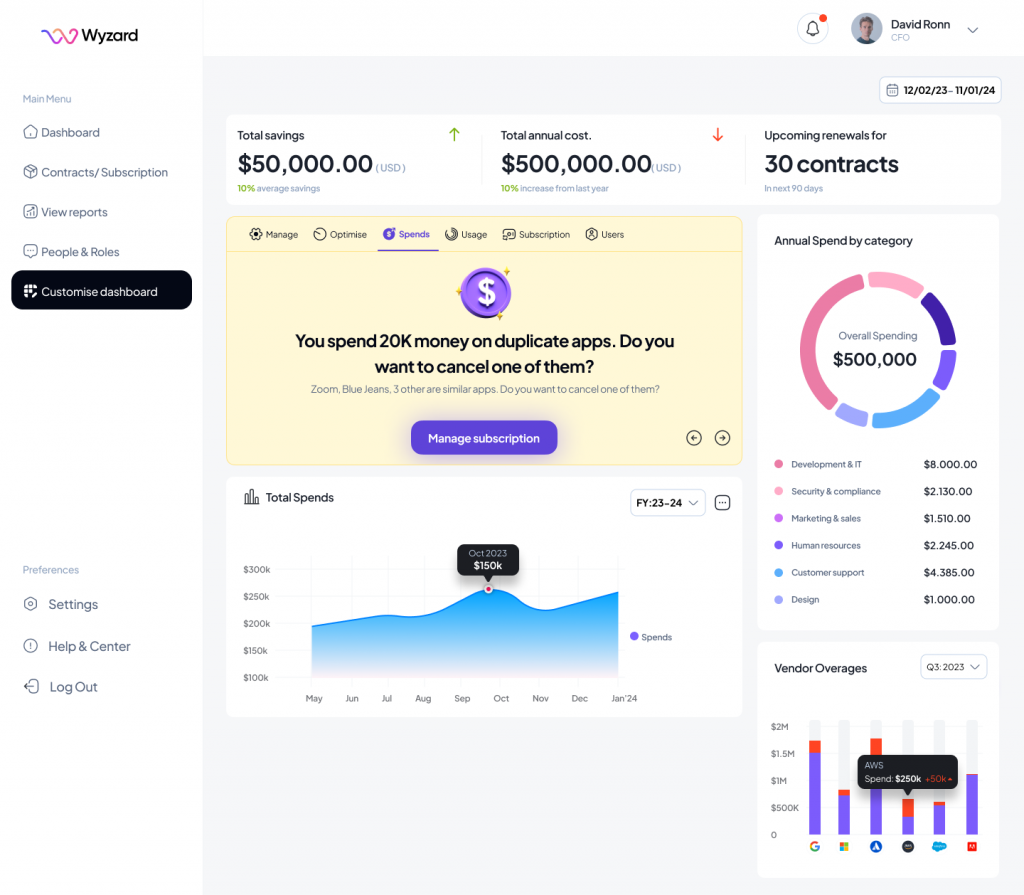
With granular spend projections, you can proactively plan for scale, shift investments as needed, and maintain a lean, high-performance tech stack aligned with your business priorities.
You see how a tech spend optimization platform like Wyzard can help CFOs do weeks’ worth of analysis in minutes. It enables you to optimize costs where you might never have known a scope for optimization exists.
Other blogs
The latest industry news, interviews, technologies, and resources.
March 17, 2025
How LLM-Based AI Agents are Simplifying the Software Buying Process for Businesses
Let’s talk about something that’s becoming a game-changer in our daily lives: AI agents. Think of them as your ...

March 11, 2025
Is Your Business Ready for CRM Software? Find Out Now!
Running a small business can feel like juggling a million things at once. You are busy with customers, ensuring ...

Subscribe
Today!
Error: Contact form not found.
Subscribe to learn about new product features, the latest in technology, solutions, and updates.
 Meet Us at
Meet Us at 
